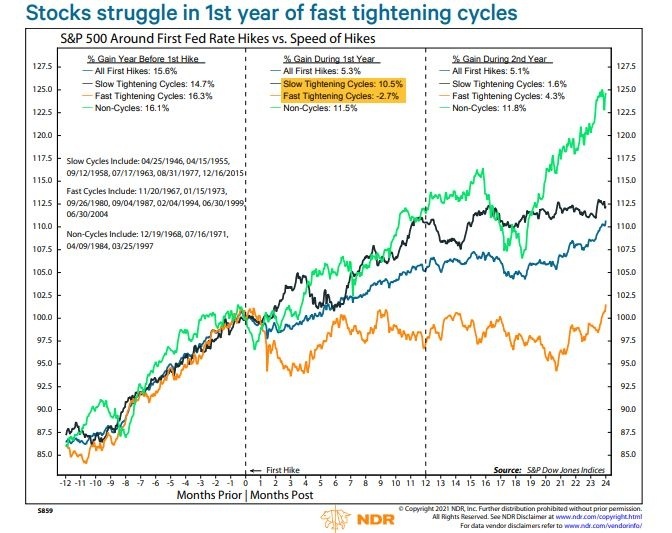Leveraged ETF 討論區 (7)
Outliers
1001 回覆
12 Like
2 Dislike
不斬!不斬!
都係唔好亂gel頭
股債期貨都想掉頭咁款
股債期貨都想掉頭咁款
如果連續幾次30% 調整後upro 都同sig line有一段距離都繼續 ?
?
 ?
?仲有風雲派

連續幾次30%? 世界大戰喎
冇諗咁遠,金融海嘯都有反彈信號
唔使諗得咁消極㗎喎,股市有佢自己嘅規矩

冇諗咁遠,金融海嘯都有反彈信號
唔使諗得咁消極㗎喎,股市有佢自己嘅規矩
律
十二月過後仲喺度再講
都係嗰句,我剩係為睇圖,佢俾人屌走我都唔開心

都係嗰句,我剩係為睇圖,佢俾人屌走我都唔開心

放咁D走先
星期五公佈通脹數據
星期五公佈通脹數據




CPI預測6.8%,真心幾癲,見到都有啲驚
https://hk.investing.com/economic-calendar/cpi-733
Core CPI預測4.9%
https://hk.investing.com/economic-calendar/core-cpi-736
https://hk.investing.com/economic-calendar/cpi-733
Core CPI預測4.9%
https://hk.investing.com/economic-calendar/core-cpi-736
快速加息
如果要想像UPRO + TMF都輸身家嘅情況…..
最大機會係券商職員偷哂客戶啲錢
最大機會係券商職員偷哂客戶啲錢

可參考呢張圖
嚟嚟去去都係得4幅圖
係咪咁神準先

係咪咁神準先
可能要重演70年代石油危機+通脹失控 s&p跌 2/3,長債都跌一半
不過搵返歷史新聞睇,果陣係陷球剷,港股跌90%,港樓跌60%
不過搵返歷史新聞睇,果陣係陷球剷,港股跌90%,港樓跌60%
幫大家重溫吓歷史:
首先睇吓維基百科。
US inflation, which peaked at 14.8 percent in March 1980, fell below 3 percent by 1983. The Federal Reserve board led by Volcker raised the federal funds rate, which had averaged 11.2% in 1979, to a peak of 20% in June 1981. The prime rate rose to 21.5% in 1981 as well, which helped lead to the 1980–1982 recession, in which the national unemployment rate rose to over 10%.
https://en.wikipedia.org/wiki/Paul_Volcker#Chairman_of_the_Federal_Reserve
跟住睇吓聯儲局官員點講依段歷史:
How bad was the period of the Great Inflation? The inflation rate, a mere 1 percent in 1965, hit 14 percent by 1980. Unemployment trended up from a low of 3.5 percent (annual average) in 1969 to 9.7 percent in 1982.The stock market was in the dumps. Oil prices jumped off the charts. Presidents Richard Nixon and Jimmy Carter became desperate enough to tinker with price controls, the results being disastrous.
Volcker, in office only two months, took the radical step of switching Fed policy from targeting interest rates to targeting the money supply. The days of "easy credit" turned into the days of "very expensive credit." The prime lending rate exceeded 21 percent. Unemployment reached double digits in some months. The dollar depreciated significantly in world foreign exchange markets. Volcker's tough medicine led to not one, but two, recessions before prices finally stabilized.
https://www.stlouisfed.org/publications/regional-economist/january-2005/volckers-handling-of-the-great-inflation-taught-us-much
到底美國會唔會俾依段歷史重演呢?
首先睇吓維基百科。
US inflation, which peaked at 14.8 percent in March 1980, fell below 3 percent by 1983. The Federal Reserve board led by Volcker raised the federal funds rate, which had averaged 11.2% in 1979, to a peak of 20% in June 1981. The prime rate rose to 21.5% in 1981 as well, which helped lead to the 1980–1982 recession, in which the national unemployment rate rose to over 10%.
https://en.wikipedia.org/wiki/Paul_Volcker#Chairman_of_the_Federal_Reserve
跟住睇吓聯儲局官員點講依段歷史:
How bad was the period of the Great Inflation? The inflation rate, a mere 1 percent in 1965, hit 14 percent by 1980. Unemployment trended up from a low of 3.5 percent (annual average) in 1969 to 9.7 percent in 1982.The stock market was in the dumps. Oil prices jumped off the charts. Presidents Richard Nixon and Jimmy Carter became desperate enough to tinker with price controls, the results being disastrous.
Volcker, in office only two months, took the radical step of switching Fed policy from targeting interest rates to targeting the money supply. The days of "easy credit" turned into the days of "very expensive credit." The prime lending rate exceeded 21 percent. Unemployment reached double digits in some months. The dollar depreciated significantly in world foreign exchange markets. Volcker's tough medicine led to not one, but two, recessions before prices finally stabilized.
https://www.stlouisfed.org/publications/regional-economist/january-2005/volckers-handling-of-the-great-inflation-taught-us-much
到底美國會唔會俾依段歷史重演呢?

送多個point俾淡友,淡友可以講埋Nifty Fifty。
在美國,Nifty Fifty一詞是對 1960 年代和 1970 年代紐約證券交易所大約 50隻大盤股的非正式名稱,這些股票被廣泛認為是可靠的買入和持有成長股,或“藍色-芯片“股票。歷史學家認為這50隻股票推動了1970 年代初的牛市,而它們隨後在1980年代初的崩盤和表現不佳是一個例子,說明在此期間許多投資者忽略基本股票估值指標,而是民意決定。大多數漂亮的五十年代已經康復並且表現出色,儘管現在有一些已經不復存在或一文不值。
https://en.wikipedia.org/wiki/Nifty_Fifty
所謂的「Nifty Fifty」,意指在上世紀六十年代至七十年代,有幾十隻藍籌股或大價股,長升不跌,因而在股民心目中,造成了「有買貴,無買錯」的心理,結果炒到了50倍市盈率,股價崩潰,熊市出現。
https://www.am730.com.hk/column/%E8%B2%A1%E7%B6%93/%E4%BB%8A%E6%97%A5%E7%BE%8E%E8%82%A1%E5%B0%87%E6%98%AFnifty-fifty%E7%BF%BB%E7%89%88-181000
FANGAM 在當前美股的地位,猶如 1960-70 年代初的「漂亮 50(Nifty Fifty)」,具有強大的品牌實力,並吸引投資人瘋狂搶進,包括可口可樂、迪士尼、IBM、Philip Morris、麥當勞和寶潔等。
「漂亮 50」還可以再細分兩組,便宜的一組,本益比約為 28 倍,貴的一組約為 60 倍,但兩組股票在接下來 10 年都表現欠佳。而當前 FANGAM 的估值,就接近「漂亮 50」廉價股的估值。
如果,投資人在 1972 年買進了可口可樂或麥當勞,又或者是「漂亮 50」的任何一個成員,那麼接下來會面對零回報的 10 年。實際上,由 1972-1974 年,可口可樂雖然一樣強大,但股價卻下挫 50%。投資人要到 1980 年初,才有解套的時候,還別提賺錢了。
https://news.cnyes.com/news/id/4497994
在美國,Nifty Fifty一詞是對 1960 年代和 1970 年代紐約證券交易所大約 50隻大盤股的非正式名稱,這些股票被廣泛認為是可靠的買入和持有成長股,或“藍色-芯片“股票。歷史學家認為這50隻股票推動了1970 年代初的牛市,而它們隨後在1980年代初的崩盤和表現不佳是一個例子,說明在此期間許多投資者忽略基本股票估值指標,而是民意決定。大多數漂亮的五十年代已經康復並且表現出色,儘管現在有一些已經不復存在或一文不值。
https://en.wikipedia.org/wiki/Nifty_Fifty
所謂的「Nifty Fifty」,意指在上世紀六十年代至七十年代,有幾十隻藍籌股或大價股,長升不跌,因而在股民心目中,造成了「有買貴,無買錯」的心理,結果炒到了50倍市盈率,股價崩潰,熊市出現。
https://www.am730.com.hk/column/%E8%B2%A1%E7%B6%93/%E4%BB%8A%E6%97%A5%E7%BE%8E%E8%82%A1%E5%B0%87%E6%98%AFnifty-fifty%E7%BF%BB%E7%89%88-181000
FANGAM 在當前美股的地位,猶如 1960-70 年代初的「漂亮 50(Nifty Fifty)」,具有強大的品牌實力,並吸引投資人瘋狂搶進,包括可口可樂、迪士尼、IBM、Philip Morris、麥當勞和寶潔等。
「漂亮 50」還可以再細分兩組,便宜的一組,本益比約為 28 倍,貴的一組約為 60 倍,但兩組股票在接下來 10 年都表現欠佳。而當前 FANGAM 的估值,就接近「漂亮 50」廉價股的估值。
如果,投資人在 1972 年買進了可口可樂或麥當勞,又或者是「漂亮 50」的任何一個成員,那麼接下來會面對零回報的 10 年。實際上,由 1972-1974 年,可口可樂雖然一樣強大,但股價卻下挫 50%。投資人要到 1980 年初,才有解套的時候,還別提賺錢了。
https://news.cnyes.com/news/id/4497994